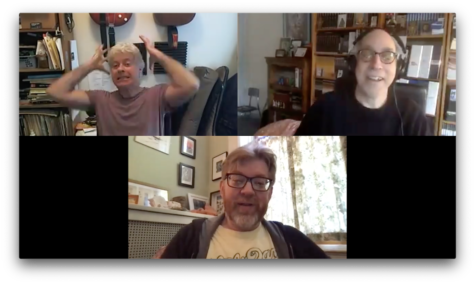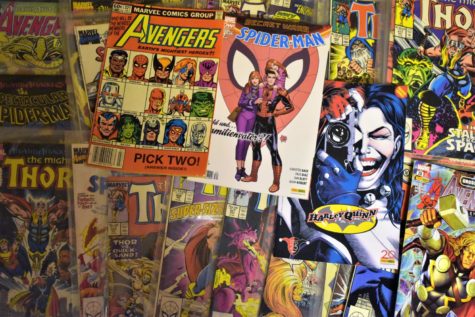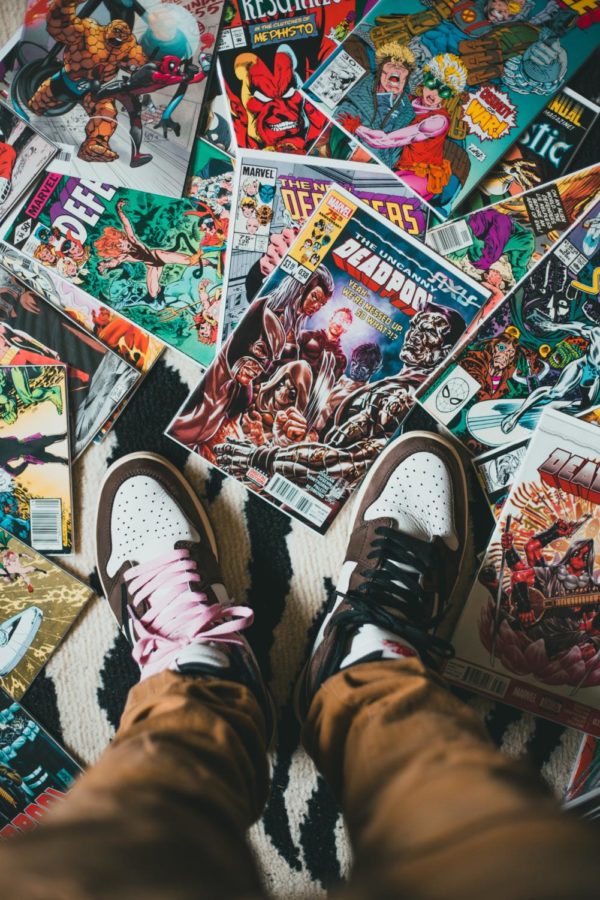Queer Heroes in Marvel Comics
Marvel comics are doing well with LGBTQ+ representation, but the movies are very much not, and it’s hard to tell why.
Marvel comics offer a long history of complex LGBTQ+ representation.
Often, the only perspectives that kids get on the world are from the people in their lives and the media they consume, and if the people in their lives are all straight and cisgender, media is the only chance they have of accessing LGBTQ+ stories.
Enter: Marvel movies!
Kids love them, families watch them, and the comics lay a great groundwork for LGBTQ+ representation that could be easily applied to films.
But the LGBTQ+ potential in the Marvel Cinematic Universe (MCU) is not being realized. Loki and an unnamed man from a support group in “Avengers: Endgame” were the only officially LGBTQ+ characters until the “Eternals” movie came out. Support Group Man only has one line and is never seen again. Loki was confirmed to be bisexual in one line from his recent Disney+ show, and only confirmed to be genderfluid on a glorified character sheet that has less than three seconds of screen time. Phastos, from the new Eternals movie, is canonically gay and has a husband and child. He and his husband actually kiss on screen, which is a groundbreaking first for the Marvel movies. Sadly, Eternals is ranked as the third worst MCU movie ever.
The Marvel comics, to the contrary, offer fans a diverse range of LGBTQ+ characters, and have for decades.
Arguably, the first gay character in the comics is Arnie Roth, who first appeared in a Captain America comic (#268) in 1982. Arnie Roth is gay, Jewish, and best friends with Captain America. (Interestingly, MCU Bucky Barnes is actually a combination of Arnie Roth and the comics’ Bucky Barnes, although Arnie’s gay and Jewish identities didn’t make the movies.)

Arnie Roth’s creator, writer J.M. DeMatteis, was never allowed to make Arnie or his boyfriend openly gay, but he made it as clear as he could. In an interview for the podcast “Grown A** Men”, DeMatteis discussed his reasoning for including Arnie in the comics.
J.M. DEMATTEIS: It’s just what you do when you write Captain America. If we have a guy whose name is Captain America and he’s got a flag on his suit, if you’re just having him fight villains and you’re not dealing with [real world] stuff then, you know, it could be any character in the world. I wasn’t trying to make any grand statement! I was just… this is Captain America! His girlfriend’s Jewish! His best friend, Sam Wilson, is a Black guy, you know, so of course he would have another friend who was gay. He would have to be surrounded by people who represent all of America, not just a small slice of it.
This wasn’t a decision that went over readers’ heads.
J.M. DEMATTEIS: I’ve had a lot of people come to me over the years about that story and how much it meant to them and how much it still means to them that that character exists.
The 1970s brought us Don McGregor’s “Panther’s Rage” comics, about Black Panther. Within those comics, readers meet not only T’challa, but Taku and Venomm (no relation to Venom from Spider Man). Villain Erik Killmonger set Venomm on Wakanda as a weapon, but he was captured and imprisoned by Taku. The two grow close during Venomm’s time in capture, and Taku eventually helps Venomm get a chance to prove himself as an ally of Wakanda.
They have a romantically charged relationship from the get-go, which was never an accident. In an interview with Marvel’s Ben Morse, McGregor talked about his intentions with Taku and Venomm, and why they never actually kissed.
DON MCGREGOR: Taku and Venomm were the first characters I ever did that were intended to be gay. But after the complications of doing an interracial kiss in KILLRAVEN came about [in AMAZING ADVENTURES #31], I knew that would be my last book if I tried it. And it would never have seen print.
Surprisingly, the representation that LGBTQ+ people saw in comic books more than half a century ago is more than we’re getting in Marvel movies in 2021.
Current comics are doing it much better. Young Avengers (2005-2014) characters Miss America and Wiccan are two of the most well known LGBTQ+ characters on that team. Wiccan, who’s a fan favorite of Young Avengers readers, has gotten married (twice!) to his husband Hulkling. A Bronx Science ninth grader (who wishes to remain anonymous) and Marvel fan talked to me about America Chavez (Miss America).
NINTH GRADER: America came from the Lesbian Utopia Universe (an alternate world without men) but then it got attacked, so she came over to our universe. She can break through universes with a star shaped thing – we don’t really even know the extent of her powers yet.
Her girlfriend, Ramone Watts, is a supporting character in the comics, and Miss America has her own comic series as well as being a part of the Young Avengers. She’s reportedly going to be in the second Doctor Strange movie, which means that the Marvel Movies may have their first out lesbian as a central character. Sadly, there are issues with the casting for America Chavez.
NINTH GRADER: Regarding the new America Chavez actress, she’s not Afro-Latina, she’s just Latina, which is [part of] a big issue with colorism.
The first trans character in Marvel comics was Cloud, who is genderfluid, from the New Defenders series in the mid-80’s. Cloud is a cosmic entity who was sent to Earth in human form. They came into contact with two teenagers, Carol and Danny, who were so shocked by Cloud’s sudden appearance that they crashed their car. Cloud assumed both of their forms in an effort to heal them, and from then on, while in human form, they switch between Carol and Danny frequently. The word trans is never used to describe them in the comics, and some may not have even realized that they were reading about a genderfluid character, but that is undeniably what Cloud is.
Douglas Wolk, author of the book “All the Marvels,” commented on Cloud in another “Grown A** Men” interview.
DOUGLAS WOLK: The first genderfluid superhero character is Cloud from “New Defenders”, when Peter Gillis was writing it. It’s so [casual], just like, sometimes Cloud’s a boy! Sometimes Cloud’s a girl! All the same to Cloud. (Laughs)
Another more recent trans character, and the only human trans Marvel character in print right now, is Koi Boi from the “Squirrel Girl” comics.
DOUGLAS WOLK: One of my absolute favorites of the past few years; Koi Boi, from “The Unbeatable Squirrel Girl”, who’s not even signaled until a year into the series, when there’s a scene where Squirrel Girl and Chipmunk Hunk and Koi Boi are all changing into their superhero costumes. Somebody tweeted at Erica Henderson, the artist, “Wait is Koi Boi wearing a binder?” and Erica was like ‘Well we weren’t going to do a special episode about it or anything.’ Amazing. Love it.
I talked with the ninth grader about why they thought Marvel has so consistently had these issues in their movies, and why the representation from the comics isn’t transferring over. Some marvel fans say that the reason Marvel is so lacking in LGBTQ+ representation is because of censorship laws in other countries Others aren’t confident in that explanation.
NINTH GRADER: Some of [their reasoning]’s vague, you know? Like they say that, but [with] Eternals, a few countries banned it, because there was a gay kiss, but barely any.
With Eternals, and with the upcoming Dr. Strange movie featuring Miss America, it seems like Marvel is starting to include more central LGBTQ+ characters. Still, they’re going very slowly when they have the opportunity to go very fast. Representation is essential, and Marvel studios needs to be brave, just like Marvel comics writers were in the sixties and seventies.

A Bronx Science sophomore (who also wishes to remain anonymous) reflected on a question on how seeing more LGBTQ+ representation would have affected their experience of figuring out their sexuality.
SOPHOMORE: Huh, that’s a hard question. (Laughs) I mean, it’s hard to say. Because I did see gay people in movies growing up. I saw RENT and The Imitation Game and Rope and all of those films, but they were really centered on pain. It was hard for me to identify with that much sadness, and I think a part of me was kind of like, ‘I don’t want to be sad that way’ you know? So I guess if I had seen LGBTQ+ people being happy, like in Marvel, yeah, that would have made a difference.”
The Marvel comics offer fans a diverse range of LGBTQ+ characters, and have for decades.
Acadia Bost is a returning Editor-in-Chief for ‘The Science Survey.’ Placing an emphasis in their writing on the more structural, long term problems...

